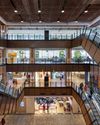Eaton Corporation’s general manager, Frank Ackland, explains how advances in fire detection systems can help facility and maintenance managers.

The rapid evolution of fire detection technology means saving more lives. Systems are now moving on from the one-size-fits all approach to providing a wide array of solutions that offer best possible protection in a range of environments, each with its own characteristics.
It is now possible to detect any or all of the main indicators of fire — smoke, heat, carbon dioxide or monoxide, and even flame. However, while this increased level of sophistication represents a huge leap forward, buyers now have various parameters to consider during their decision making process because cost, scale, location, technology, regulation, and risk assessment are all vital considerations in choosing an ideal system.
Making the right choice
Alarms that used ionisation were once the preferred option. However, problems with their disposal, in light of their radioactive components, means that they have largely been rendered redundant and are even banned in some countries. In their place, optical smoke detectors became the most common solution, especially since they have overcome high air movements that would incorrectly activate the ionisation detectors. Instead, optical systems work when smoke particles enter the chamber within the device and disturb a beam of light that triggers the alarm.
In many cases, these devices have been augmented over the past decade with the addition of heat detection elements to create a combined optothermal solution, expanding the scope of fire detection across two important indicators: smoke and heat. However, the ubiquitous use of such devices gave rise to a new challenge – a growing number of false alarms. In a kitchen, for example, the use of optothermal devices is problematic because of the heat that is ordinarily generated.
この記事は Commercial Design の March 2017 版に掲載されています。
7 日間の Magzter GOLD 無料トライアルを開始して、何千もの厳選されたプレミアム ストーリー、9,000 以上の雑誌や新聞にアクセスしてください。
すでに購読者です ? サインイン
この記事は Commercial Design の March 2017 版に掲載されています。
7 日間の Magzter GOLD 無料トライアルを開始して、何千もの厳選されたプレミアム ストーリー、9,000 以上の雑誌や新聞にアクセスしてください。
すでに購読者です? サインイン

TRENDS SHAPING URBAN WORKPLACE TRANSFORMATION
Since 2013, Gensler's the trend report has highlighted trends shaping the future; this year's edition offers a blueprint for sustainable, human-centered spaces and evolving city dynamics

GLOBAL EDITORIAL CHOICE AWARD - EXCELLENCE IN FACILITY LEADERSHIP - Vinod Mathews, Regional Director of Global Real Estate & Facilities, APAC at Amazon
Vinod Mathews' career reflects a blend of military precision and corporate expertise.

PRIDE OF INDIA-WOMAN IN FACILITY MANAGEMENT - Reshmi Shankar, Vice President and Head of Facilities Management Group for India, Sri Lanka, and Bangladesh at Wipro Limited
Reshmi Shankar leads one of the most challenging roles in corporate real estate, managing over 25 million square feet of workspace and supporting 230,000 employees with strategic precision and innovative vision.

HALL OF FAME - Irfan Rzack, Chairman and Managing Director of Prestige Group
With an illustrious career spanning decades, Irfan Razack, Chairman and Managing Director of Prestige Group, has redefined the contours of Indian real estate.

HALL OF FAME - M.R. Jaishankar, Managing Director, Brigade Group
As the driving force behind Brigade Group, M.R. Jaishankar's visionary leadership has redefined the real estate industry, integrating innovation, sustainability, and community focus into urban development.

CELEBRATING EXCELLENCE: COMMERCIAL DESIGN AWARDS 2024
The city of Bangalore recently played host to one of the most anticipated events in the commercial design and real estate industry—the Commercial Design Awards 2024. The event was a grand celebration of creativity, innovation, and excellence, drawing together a distinguished gathering of architects, designers, developers, project heads and facility managers from across the nation.

The Future of Workplace Ergonomics: A glimpse into tomorrow's workspaces
As work dynamics shift, the demand for adaptable and health-conscious office environments grows.

INCUSPAZE AIMS TO SECURE $25M FOR EXPANSION AMID GROWING DEMAND FOR FLEXIBLE WORKSPACES
Coworking firm Incuspaze is looking to raise USD 25 million (over Rs 210 crore) to expand its business across major cities before planning to launch its Initial Public Offer (IPO).

ONWARD WORKSPACES SECURES A 14,000 SQ. FT. MANAGED OFFICE TRANSACTION WITH LENSKART IN NEW DELHI
Onward Workspaces, a flexible and managed coworking solutions brand, has entered into a managed office deal with Lenskart, one of India's largest eyewear retailers.

WORKING TOGETHER
Professor Louise Valentine, Head of the Design School at Heriot-Watt University, on the importance of inclusive design in the workplace